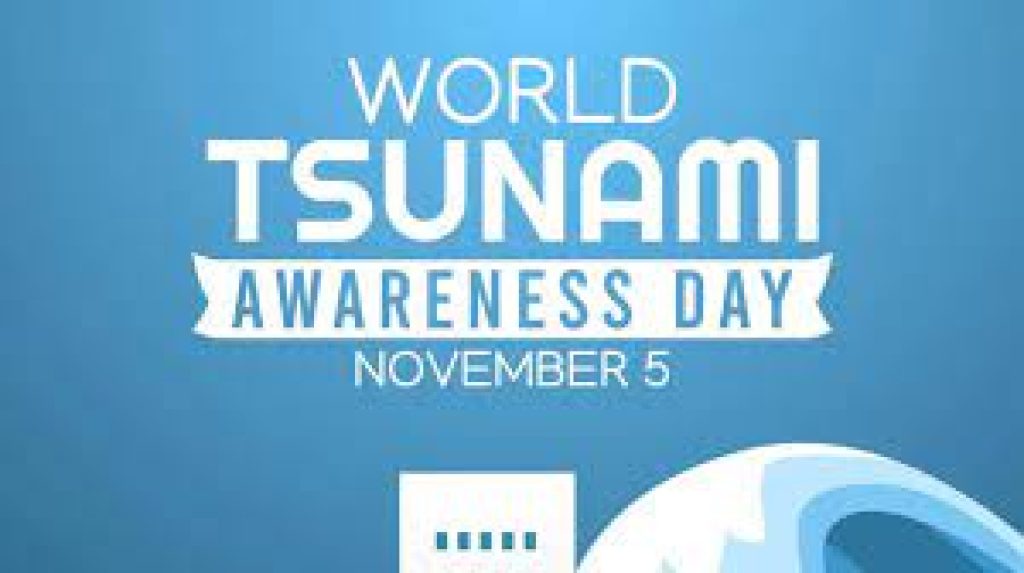World Tsunami Awareness Day 2023 Observed on 05th November

Every November 5th, a global community assembles to mark World Tsunami Awareness Day, emphasising the importance of Tsunami knowledge and awareness. Tsunamis are natural disasters of immense destructive power, often caused by underwater disturbances like earthquakes, volcanic eruptions, landslides, and even extraterrestrial collisions. These catastrophic events, though rare, have claimed countless lives throughout history. In the context of World Tsunami Awareness Day, let’s explore the causes and impacts of tsunamis and how they intersect with the global goal of reducing inequality.
Tsunamis, born from diverse underwater disturbances, are formidable natural disasters with the potential to inflict massive harm. World Tsunami Awareness Day seeks to raise awareness about these cataclysmic events while highlighting the critical role of reducing inequality in addressing their impacts. By promoting collaboration and understanding, we can work towards a more resilient and equitable future in the face of tsunamis and other natural disasters.
What are Tsunamis?
Tsunami Definition
The Japanese origins: The word “tsunami” is derived from two Japanese words: “tsu” (meaning harbor) and “nami” (meaning wave). Tsunamis, therefore, are characterized by colossal ocean waves.
Formation and Characteristics
Underwater Disturbances: Tsunamis typically result from underwater disturbances, including earthquakes, volcanic eruptions, landslides, and even extraterrestrial collisions.
Wave Characteristics: Tsunami waves often resemble towering walls of water. They can strike coastlines and remain hazardous for hours, with waves recurring at intervals of 5 to 60 minutes. Interestingly, the first wave may not be the most destructive.
Causes of Tsunamis
Tsunamis Triggered by Earthquakes
Subduction Zones: Most tsunamigenic earthquakes occur in subduction zones, where one tectonic plate sinks beneath another.
Conditions for Tsunami Generation: Four key conditions must be met for an earthquake to trigger a tsunami: it must occur beneath or near the ocean, be of substantial magnitude (at least 6.5 on the Richter Scale), rupture the Earth’s surface, and cause vertical sea floor movement.
Landslides and Tsunamis
Coastal Landslides: Coastal landslides can displace significant volumes of water into the sea, generating tsunamis.
Underwater Landslides: Submarine landslides, occurring under the ocean, can also lead to tsunami generation when dislodged material violently pushes the water ahead of it.
Volcanic Eruptions as Tsunami Sources
Rare but Destructive: Violent volcanic eruptions can displace large water volumes and generate highly destructive tsunami waves. The 1883 Krakatoa eruption in Indonesia serves as a historical example of such an event.
Extraterrestrial Collisions and Tsunamis
Extremely Rare Occurrence: While no recent meteor or asteroid-induced tsunamis have been recorded, scientists acknowledge the potential risk. If celestial bodies were to strike the ocean, they could displace vast amounts of water, causing tsunamis.
World Tsunami Awareness Day Theme 2023
Inequality and Tsunamis
The Current Theme: World Tsunami Awareness Day’s 2023 theme, “Fighting Inequality for a Resilient Future,” echoes the emphasis on reducing inequality during the International Day for Disaster Reduction.
Inequality’s Role: This theme highlights the relationship between tsunamis and inequality. It addresses how inequality can exacerbate the vulnerability of certain populations to tsunamis and how post-tsunami aftermath can push vulnerable communities further into poverty, intensifying inequality.
Background and Objectives
United Nations’ Initiative: The UN General Assembly designated November 5 as World Tsunami Awareness Day in 2015, with the objective of raising tsunami awareness and sharing innovative approaches for risk reduction.
Japan’s Leadership: Japan, due to its extensive experience in tsunami early warning systems and disaster recovery, played a pivotal role in initiating World Tsunami Awareness Day.
Global Cooperation: International efforts, such as the Hyogo Framework for Action and the Indian Ocean Tsunami Warning and Mitigation System, have been crucial in reducing tsunami risks.
The Way Forward
Growing Threats: Rapid urbanization and increasing tourism in tsunami-prone regions expose more people to tsunami risks, making risk reduction a fundamental goal of international agreements like the Sendai Framework for Disaster Risk Reduction.
Collaboration and Engagement: World Tsunami Awareness Day encourages diverse sectors of society to collaborate on disaster risk reduction, addressing both the causes and the consequences of tsunamis.